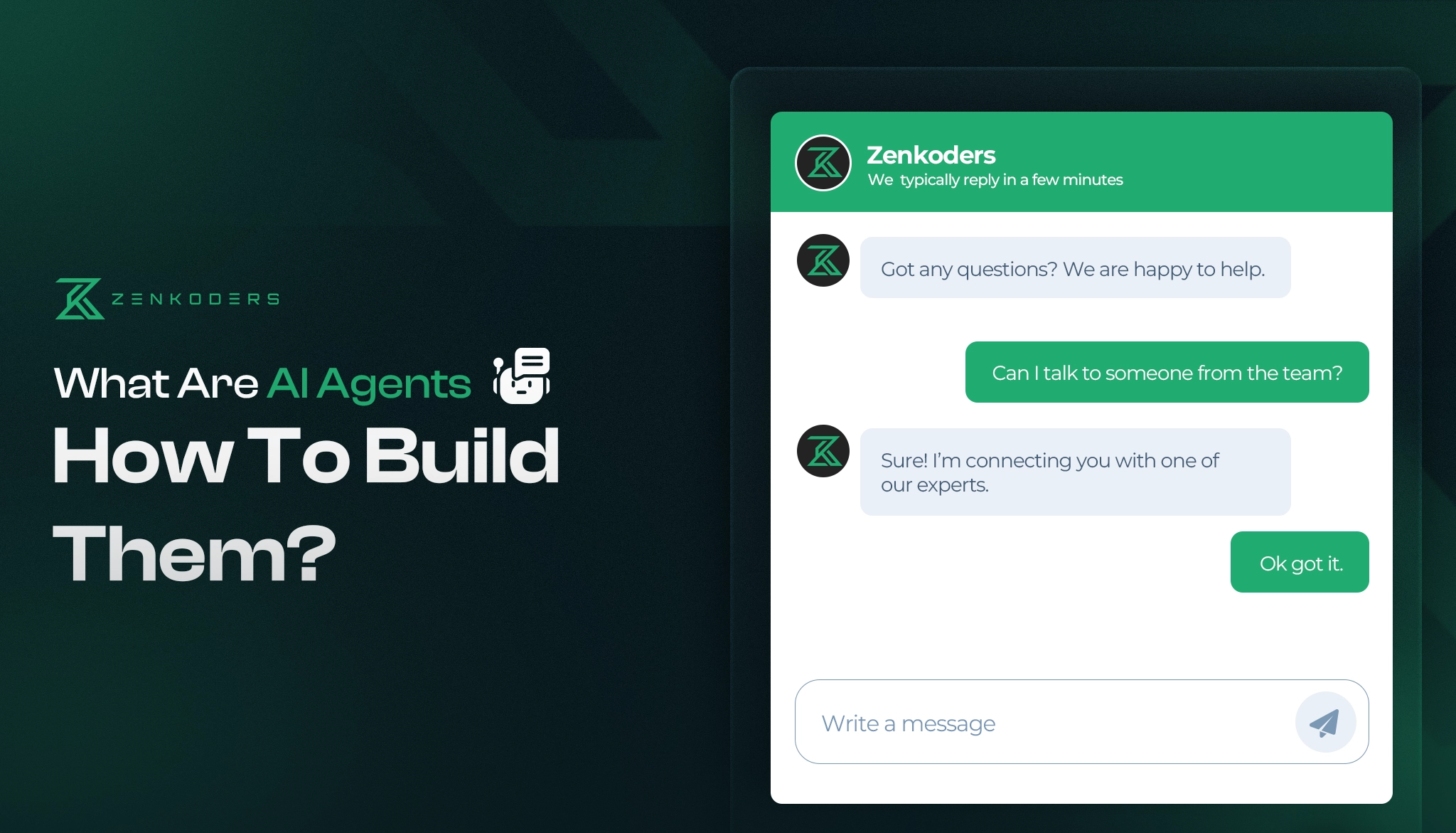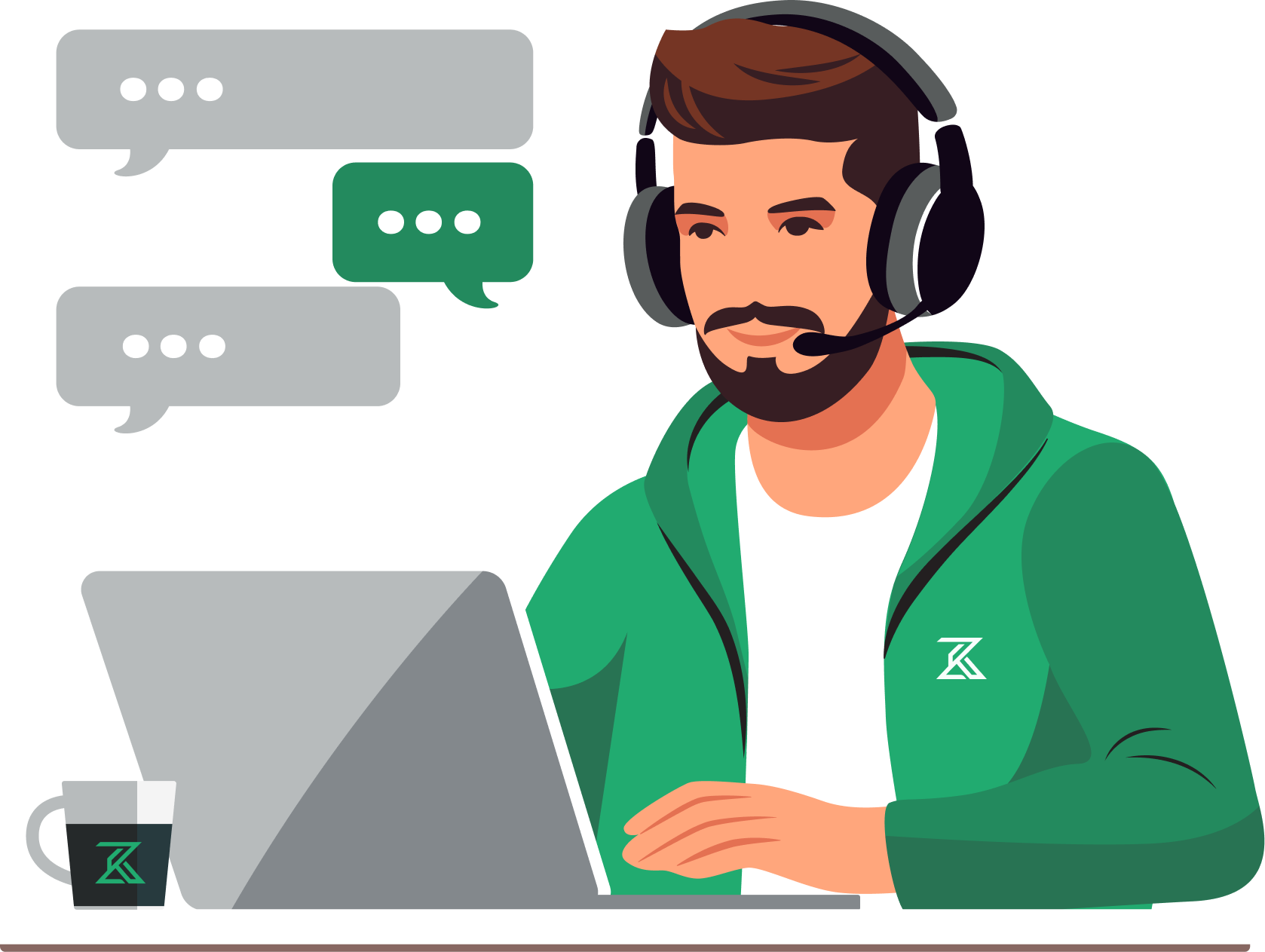We commonly hear terms like AI chatbots, intelligent agents, and autonomous AI systems all the time now. Many software developers are now shifting their focus toward building AI products and services, including AI agents. You might be wondering: exactly what are AI agents, and how do we build them? These autonomous systems solve complex problems with natural language understanding (NLU) and AI-based decision-making.
In this blog, we’ll explain what AI agents are and the steps you can take to build a career in intelligent agent development.
Looking for a large-scale, custom AI agent?
Zenkoders is a software company that will help create scalable intelligent agent solutions for your company.
What Are AI Agents?
Before answering your question “What are AI agents?”, let’s make it clear that services like ChatGPT and Copilot ARE NOT agents. They’re actually called AI chatbots, which is a slightly different concept. Chatbots take user input, process it, and then suggest possible solutions through Natural Language Processing or NLP. AI agents have an additional feature: they can perform real tasks for their users.
The difference lies in how natural language processing in AI agents is used to provide different outputs. Unlike chatbots, which require human-ai interaction, AI agents can process large amounts of unstructured data on their own. Through NLP, they rationally analyze the given data and make real decisions.
Being able to function without needing consistent human inputs makes AI agents much more valuable for businesses and enterprises. For example, an AI agent can automate repetitive tasks like writing scheduled emails to clients and processing thousands of resumes. It can also analyze large datasets of market statistics to help business leaders make decisions about their financial policies.
If you instead want to learn more about copilot agents like ChatGPT, check out our detailed copilot blog.
What Are The Principles That Define AI Agents?
To understand AI agent behavior, it’s important to look at the core principles of intelligent systems. One key principle is independent functionality. Unlike chatbots, intelligent agents can operate without constant guidance. They process large amounts of data independently, enabling them to solve complex problems without human guidance.
Another key feature of intelligent agents is the goal-driven behavior in AI, which essentially makes sure they complete the task they were programmed for. Finally, we have to understand their decision-making process. For example, AI agents can analyze market data, evaluate different options, and make rational decisions, like determining which stocks to buy or sell. This autonomy makes them a much more valuable asset to the technical side of businesses.
How Do AI Agents Work?
Wondering how AI agents work? In short, they’re independent AI systems designed to perceive, analyze, and act on their environment without much human interaction. The agents are programmed with advanced algorithms, natural language understanding (NLU), and iterative learning to achieve this functionality. We’ll help you understand the workings of artificial intelligence agents step by step.
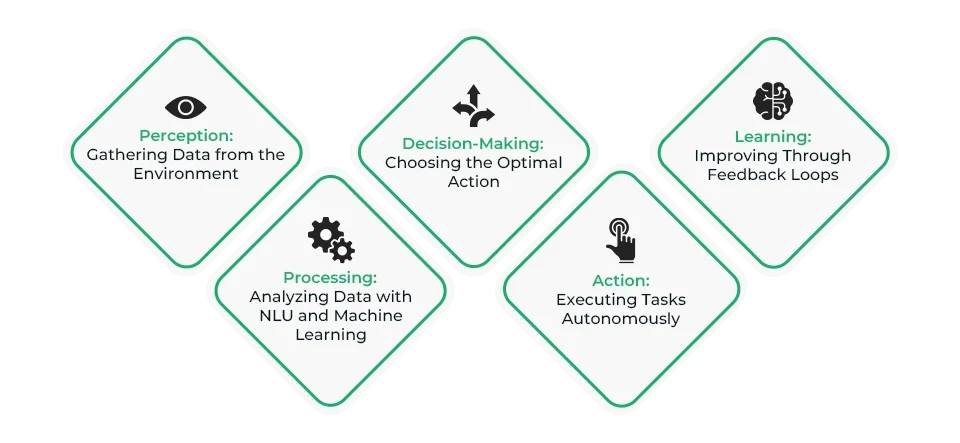
1. Perception: Gathering Data from the Environment
The first step in an AI agent’s operation is perception. Using sensors, APIs, or direct user inputs, the agent collects unstructured data from its surroundings. For example, a customer service AI agent might scan support tickets, emails, or chat logs. This stage is critical because accurate data collection ensures the agent has the necessary context to make informed decisions.
2. Processing: Analyzing Data with NLU and Machine Learning
Once data is collected, the agent processes it using natural language processing in AI agents and machine learning models. Here, NLU algorithms interpret the intent behind human language, while decision-making algorithms evaluate possible actions. For example, a financial AI agent can analyze market trends and suggest investment strategies.
3. Decision-Making: Choosing the Optimal Action
The agent compares processed data with its predefined goals and then chooses the best action based on its analysis. For example, a supply chain agent can change the route of shipments if it detects logistical problems in the previous route.
4. Action: Executing Tasks Autonomously
After deciding, the agent makes its move. Proving its utility as an independent agent, it will make its action autonomously without any human supervision. For example, an HR agent can schedule interviews or a manufacturing agent can optimize production lines.
5. Learning: Improving Through Feedback Loops
The final key functionality of AI systems is learning from outcomes. Using feedback mechanisms, they refine their models to enhance future performance. If a marketing AI agent’s campaign underperforms, it might adjust audience targeting criteria or messaging for better results.
Key Takeaway: Perception and action in AI agents are their main goals. Learning, analyzing, and learning from their experiences help them perform better. By combining NLU, goal-driven behavior, and adaptive algorithms, they automate complex tasks while evolving over time. This autonomy makes them invaluable in industries like healthcare, finance, and logistics, where speed and precision are critical.
How To Build an AI Agent?
It’s actually pretty easy to design an intelligent agent with the right guidance. To help you out, we’ll explain a clear and detailed AI agent development process that involves defining goals, selecting tools, programming behavior, and iterative testing.
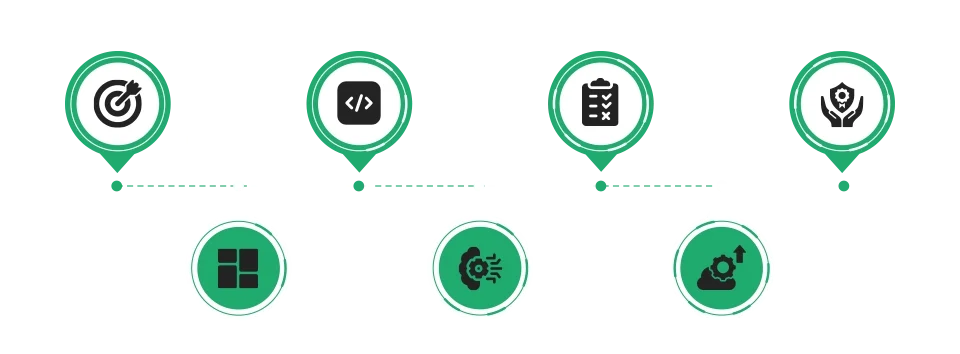
1. Define the Agent’s Purpose and Goals
Start with what problem you want to solve with your AI agent. Will it automate tedious tasks, analyze data, or help with decision-making? You need to define the behavior of your AI system by setting clear, measurable objectives. For example, you can design a sales AI agent to “increase lead conversion by 20%” or a healthcare agent could focus on “reducing patient diagnosis time by 30%.”
2. Choose the Right Tools and Frameworks
Once you’ve decided on your goal, select tools that are suited for your agent’s purpose. You can use these powerful platforms for programming AI behavior:
- Machine Learning Frameworks: TensorFlow, PyTorch, or IBM Watson for training decision-making models.
- NLP Libraries: spaCy, Hugging Face, or Google’s BERT for natural language processing in AI agents.
- Cloud Services: AWS SageMaker, Google Cloud AI, or Azure Machine Learning for scalable infrastructure.
3. Develop the Agent’s Architecture
Now it’s time to design the agent’s workflow according to how AI agents usually work:
- Perception Layer: Integrate APIs, sensors, or user interfaces to collect data.
- Processing Layer: Use NLU models to interpret inputs and machine learning algorithms to analyze data.
- Decision Engine: Implement reinforcement learning, rule-based systems, or neural networks for AI-based decision-making.
- Action Module: Connect to external systems (e.g., CRMs, email platforms) to execute tasks.
4. Train the AI Model
Feed your agent with high-quality, domain-specific data to train its models. For instance:
- A customer service agent needs historical chat logs and resolution data.
- A stock-trading agent requires market trends, company financials, and risk metrics.
Use techniques like supervised learning (for labeled data) or reinforcement learning (for trial-and-error scenarios) to refine autonomous AI systems.
5. Test and Iterate
Validate your agent’s performance in controlled environments. Test edge cases, like ambiguous user queries or incomplete data, to ensure robustness. For example, if an HR AI agent misinterprets a resume, tweaks its NLP models, or expands its training dataset. Continuous iteration is key to designing intelligent agents that adapt to real-world complexity.
6. Deploy and Monitor
Launch the agent in a live environment, but keep monitoring its performance. Tools like Prometheus or AWS CloudWatch can track metrics such as accuracy, response time, and user satisfaction. Update the agent regularly with new data and feedback to maintain its relevance.
7. Ensure Ethical Compliance
Address biases in training data and decision algorithms. For example, a loan-approval AI agent must avoid discriminatory practices based on gender or ethnicity. Implement transparency features, like explaining why a decision was made, to build trust.
Key Takeaway: These AI agent creation steps blend technical precision with strategic planning. By focusing on goal-driven behavior, robust architecture, and ethical practices, you can build autonomous AI systems that deliver measurable value. Whether streamlining operations or enhancing customer experiences, AI agents are reshaping industries—one intelligent decision at a time.
What Are The Types of AI Agents?
AI agents come in various forms, each tailored to solve specific problems or operate in distinct environments. Understanding these types of intelligent systems helps developers choose the right architecture for their goals. Below, we’ll explore the classification of artificial intelligence agents, from basic reactive systems to advanced learning-based models.
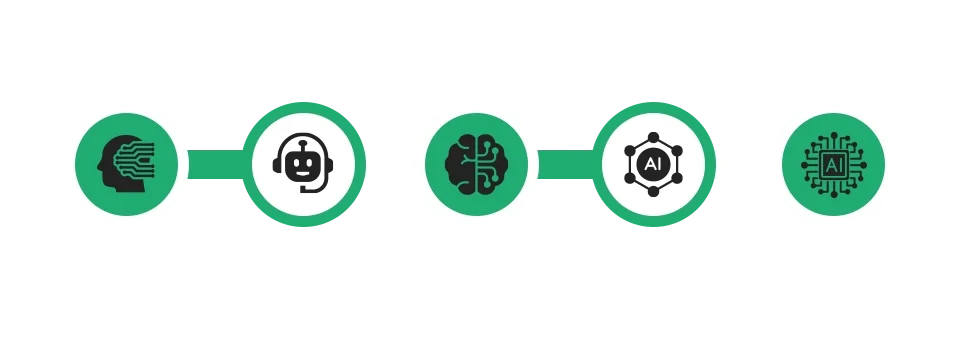
1. Reactive Agents
Reactive agents operate on a simple principle: respond to immediate stimuli without considering past experiences or future consequences. They use pre-programmed rules to react to current inputs. For example, a thermostat that adjusts room temperature based on real-time sensor data is a reactive agent. While efficient for straightforward tasks, these agents lack adaptability in dynamic environments.
2. Proactive (Goal-Based) Agents
Proactive agents are driven by predefined objectives. Unlike reactive agents, they plan actions to achieve long-term goals. For instance, a logistics AI agent might optimize delivery routes to minimize fuel costs over a week. These systems use goal-driven behavior in AI to evaluate multiple scenarios and select the best path forward, making them ideal for complex decision-making.
3. Learning-Based AI Agents
Learning-based AI agents improve their performance over time using machine learning. They analyze historical data, learn patterns, and adapt their behavior. A recommendation engine on Netflix or Amazon, which refines suggestions based on user interactions, is a classic example. Techniques like supervised learning, reinforcement learning, and neural networks power these autonomous AI systems, enabling them to evolve with new information.
4. Collaborative Agents
Collaborative agents work in tandem with humans or other AI systems. They excel in environments requiring teamwork, such as healthcare diagnostics or autonomous vehicle networks. For example, a collaborative AI agent in a hospital might cross-reference patient data with a doctor’s notes to suggest treatment plans. These agents prioritize human-AI interaction and communication to achieve shared objectives.
5. Hybrid Agents
Hybrid agents combine elements of reactive, proactive, and learning-based systems. They balance real-time responsiveness with strategic planning. For example, an automatic car uses reactive algorithms to avoid obstacles, planning to navigate routes, and machine learning to adapt to traffic patterns.
Key Takeaway: AI agents have many types from basic-ruled systems to self-adapting. Understanding these classifications of artificial intelligence agents will help you design solutions that fit your project’s needs.
When Should You Use AI Agents and When to Avoid?
Intelligent agents are powerful tools but they’re not the best choice for every task. Let’s look at the limitations and use cases of AI agents so you can deploy them without wasting resources or taking risks. Learn where AI agents shine—and where they fall short.
Comparison Table: Strengths and Weaknesses of AI Agents
Scenario | When to Use AI Agents | When to Avoid AI Agents |
Task Type | Repetitive, rule-based tasks (e.g., password resets, data entry). | Tasks requiring emotional intelligence (e.g., therapy creative storytelling). |
Decision Context | Real-time decision-making with large datasets (e.g., fraud detection, stock trading). | High-stakes ethical decisions (e.g., criminal sentencing, loan approvals). |
Data Environment | Large-scale data analysis (e.g., medical imaging, market trend prediction). | Low-data or rapidly changing contexts (e.g., niche markets, viral trends). |
Scalability Needs | Scalable operations (e.g., HR screening, IoT monitoring). | Ambiguous/unpredictable environments (e.g., crisis management, innovation). |
Human Interaction | Enhancing expertise (e.g., legal research, Engineering prototypes). | High trust requirements (e.g., patient diagnostics, financial advice). |
Key Takeaway: The best scenarios for AI agent applicability are automation, scalability, and data-driven tasks. They can’t replace human creativity, morality, or empathy. It’s best to use them in generic and repetitive tasks, but avoid using them in sensitive, unique matters like legal problems. By balancing AI agent applicability with human oversight, businesses unlock efficiency without compromising trust or innovation.
What Are the Benefits of Using AI Agents?
AI agents are transforming industries by automating workflows and scaling operations. The impact of AI agents on efficiency and ability to handle complex tasks has made them essential for modern enterprises. Let’s take a look at all the benefits of AI agents.

1. Supercharged Efficiency and Productivity
AI agents automate repetitive and boring tasks and let employees focus on more strategic work. For example:
- Customer service: AI agents can automate ticket routing, reducing response times by 50-70%.
- Data entry: Auto-processing invoices or resumes cuts manual effort by 80%.
2. Cost Savings Through Scalable Automation
Unlike human teams, AI agents scale effortlessly without proportional cost increases. For instance:
- E-commerce: Personalized recommendations for millions of users require no additional staffing.
- Manufacturing: Monitoring IoT sensors across factories prevents costly downtime. Reports show that businesses using AI agents reduce operational costs by 30-50% through improved automation with AI.
3. Better Decision-Making
AI agents analyze vast datasets faster and more accurately than humans. Examples include:
- Finance: Predicting market trends using historical data and real-time indicators.
- Healthcare: AI agents are helping doctors perform better diagnoses by pointing out hidden trends in unstructured patient data.
4. 24/7 Availability and Consistency
AI agents operate round-the-clock without fatigue. Benefits include:
- Global customer support: Resolving queries in multiple time zones.
- Supply chain management: Adjusting logistics routes during disruptions, day or night.
This consistency ensures reliable service delivery, even during peak demand.
5. Enhanced Customer Experiences
By leveraging natural language understanding (NLU), AI agents personalize interactions at scale:
- Retail: Recommending products based on browsing history.
- Banking: Detecting fraud in real time to protect accounts.
According to IBM, companies using AI agents see a 40% increase in customer satisfaction.
6. Accelerated Innovation
AI agents simulate scenarios and test hypotheses faster than human teams. For example:
- Engineering: Prototyping designs in hours instead of weeks.
- Marketing: A/B testing campaigns across channels simultaneously.
This agility helps businesses stay ahead in competitive markets.
Key Takeaway: AI agents are changing how entire industries operate. They increase working efficiency, reduce costs, and work 24/7. This allows businesses to start new ventures faster than ever before. For any smart modern company, the power of AI agents is a must-have for peak performance.
What Are the Challenges of Using AI Agents?
While AI agents offer transformative benefits, they also come with significant hurdles. Understanding these limitations of AI agents is critical to deploying them responsibly and effectively. Below, we break down the key challenges—from technical constraints to ethical dilemmas—that organizations must address.
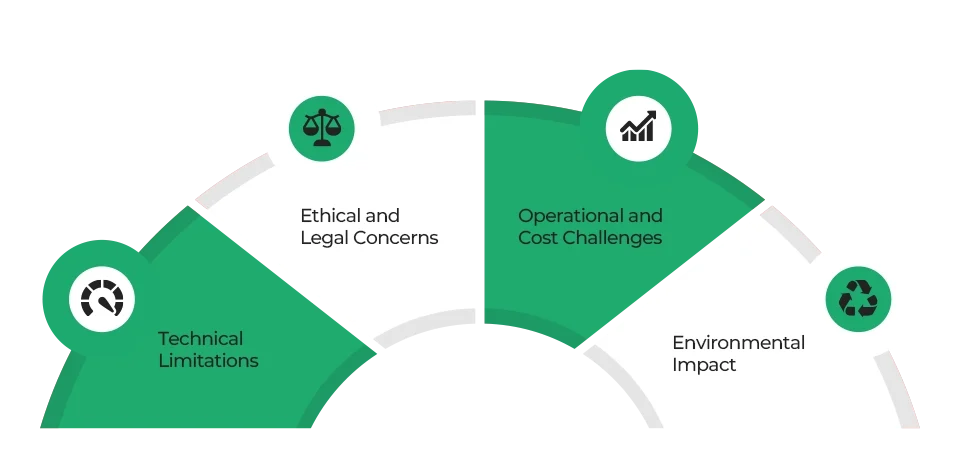
1. Technical Limitations
Data Dependency and Quality agents rely heavily on high-quality, relevant data. Poor or biased datasets lead to flawed decisions. E.g.: biased hiring agents trained on specific datasets, and bad diagnoses due to incomplete patient data.
Scalability and Complexity While agents excel at repetitive tasks, scaling them for dynamic environments is tough. E.g.: automatic vehicles in bad weather, customer support agents handling complex queries, or foreign languages.
Integration with Legacy Systems: Many businesses use outdated infrastructure that lacks APIs or cloud compatibility. Retrofitting AI agents into these systems often requires costly overhauls.
2. Ethical and Legal Concerns
Bias and Discrimination: Unfiltered training data can unfortunately make intelligent agents biased. e.g: facial recognition systems sometimes refuse to identify people of certain skin colors.
Transparency and Accountability: The nature of AI decision-making makes it hard to trace how conclusions are reached. Who is responsible if an AI misdiagnoses a patient? How would companies make audits of decisions made by AI agents?
Privacy Risks: Agents collecting sensitive data (e.g., health records, financial info) risk breaches or misuse. Compliance with regulations like GDPR or HIPAA adds complexity.
3. Operational and Cost Challenges
High Development Costs: It takes great skill in machine learning, NLP, and cloud computing to build AI agents—skills that are expensive to acquire or outsource.
Ongoing Maintenance: Agents require constant updates to stay relevant. For example, retail models need new market data to stay up-to-date, and cybersecurity agents need constant virus updates.
User Resistance: Employees and customers may distrust AI-driven decisions. A Salesforce study found that 60% of users hesitate to rely on AI for critical tasks without human oversight.
4. Environmental Impact
Training large AI models consumes massive computational power, contributing to carbon emissions. For instance:
- A single NLP model like GPT-3 can emit as much CO2 as five cars over their lifetimes.
Key Takeaway: The challenges of AI agents—from ethical concerns in AI usage to technical and operational hurdles—demand careful planning. Organizations must prioritize transparent design, bias mitigation, and sustainable practices to harness AI’s potential responsibly. By addressing these limitations head-on, businesses can build trust and maximize the value of autonomous AI systems.
What Are The Best AI Agents and Software Tools?
If you’re looking for some AI agents to help with your own tasks or workplace, you can use these intelligent agents for all your automation needs:
Coding Assistants:
- GitHub CoPilot
- OpenDevin
AI Agents
AI Agent Builders
Workflow Automation Agents:
In Summary
Now you know how AI agents are changing the business landscape. Understanding what AI agents are and how to build them is essential for businesses and skilled workers to keep up with the market. With the right planning, ethical practices, and robust tools, AI agents can bring incredible value to you and your company. To get started, either use a pre-built agent or build your own using our full guide!
Read our more tech blogs and AI-specific articles

